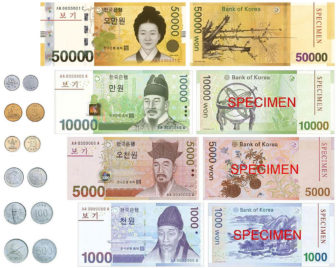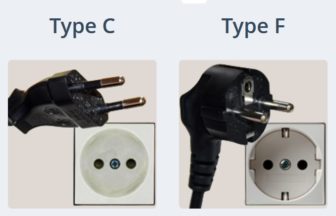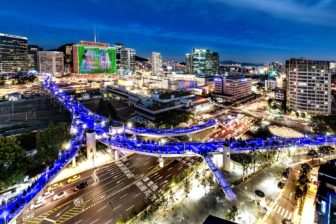
Currency | Language | Electricity | Mobile
Weather & What to Wear | Health | Tourist Destinations
Currency
 The currency in South Korea is the Korean Won (KRW). The exchange rate is subject to market fluctuation, but usually US$1 equals approximately KRW 1,000. Banknotes come in denominations of 1,000, 5,000, 10,000, and 50,000. While most places accept credit card payments, it is a good idea to keep a stash of small denomination notes.
The currency in South Korea is the Korean Won (KRW). The exchange rate is subject to market fluctuation, but usually US$1 equals approximately KRW 1,000. Banknotes come in denominations of 1,000, 5,000, 10,000, and 50,000. While most places accept credit card payments, it is a good idea to keep a stash of small denomination notes.
Alert on ATMs: Although ATMs are widespread in Seoul, many foreign visitors report trouble using their cards in Korean machines. Be sure to bring back-up cash or traveler’s checks that you can use at the currency exchange booths at the airports, banks and elsewhere.
Make sure to bring valid ID since some banks will ask for ID when making transactions. Both Incheon International Airport and Gimpo International Airport provide foreign currency exchange services. If you missed the chance to exchange currency at the airport, there are also many places to exchange money near the Conference venue in Seoul Station and Myeongdong.
Language
The official language spoken in South Korea is Korean. The writing system known as ‘Hangul’ was invented from scratch for the Korean language by King Sejong in 1446. Many people may also understand basic English in Seoul.
Useful Expressions
안녕하세요(An-nyeong-ha-se-yo) – Hello/Goodbye
반갑습니다(Ban-gap-sum-ni-da) – Nice to meet you
감사합니다(Kam-sa-ham-ni-da) – Thank you
잠시만요(Jam-shi-man-yo) – Excuse me/just a moment
미안합니다(Mi-an-ham-ni-da) – I’m sorry
네/예(Ne/Ye) – Yes
아니요(Aniyo) – No
한국말 잘 못해요(Han-guk-mal jal mot-hae-yo) – I can’t speak Korean well
얼마예요? (Ol-ma-ye-yo) – How much is it?
깎아주세요(Kka-kka-ju-se-yo) – Give me a discount
화장실 어디예요? (Hwa-jang-shil o-di-ye-yo) – Where is the bathroom?
맥주(Maek-ju) – Beer
소주(So-ju) – Soju (a type of clear spirit, a little stronger than wine; Korean vodka)
소맥(Somaek) – Somaek (a beer cocktail made with soju and beer that Koreans enjoy drinking)
건배(Geonbae) – Cheers!
Electricity
 In South Korea the standard voltage is 220V and the frequency is 60Hz. If the standard voltage in your country is between 100V – 127V (as in the US, Canada and most South American countries) you need a voltage converter in South Korea. Power sockets are of type C (also known as the standard “Euro” plug) and F (also known as “Schuko”).
In South Korea the standard voltage is 220V and the frequency is 60Hz. If the standard voltage in your country is between 100V – 127V (as in the US, Canada and most South American countries) you need a voltage converter in South Korea. Power sockets are of type C (also known as the standard “Euro” plug) and F (also known as “Schuko”).
Mobile
Most areas in South Korea support 4G LTE and 3G. South Korea has 3 major mobile network operators:
- SK Telecom
- KT Olleh (by Korea Telecom)
- LG U+
Prepaid SIM cards are available in Incheon Airport or major convenience stores. You may also use the portable Wifi router (Egg) rental service upon your arrival at the airport.
HOTLINES AND IMPORTANT NUMBERS:
Country code: 82
Seoul city code: 02
Police: 112
Emergency ambulance/Fire Department: 119
Korea Travel Hotline (free interpretation service): 1330
Weather & What to Wear
Early October is one of the best times to visit Seoul. With the beautiful autumn skies and comfortable breeze, most days are sunny with mild temperature between 7°C/45°F and 18°C/64°F. You may need long-sleeve shirts during the day and lightweight jackets for chilly evenings.
Health
There are no special vaccination requirements for visiting Korea. However, air pollution is common in Seoul throughout the year. Residents and visitors, especially those with respiratory problems are advised to stay indoors or use masks when the concentration levels of dust particles are high.
Most pharmacies stock some Western medicine, and emergency medicine such as tylenol are available in convenience stores. If you have a language problem in describing the medicine you want, dial 1330 (Korea Travel Hotline – free interpretation service) and explain what you want and ask the interpreter to explain in Korean.
Tourist Destinations
Official maps and guidebooks for tourists provided by Seoul city are available for free. Download them online at visitseoul.net. Guidebooks on specific topics such as Muslim dining, medical tourism, what and where to eat are also included.
Places to Explore in Seoul
Seoullo 7017

Copyright (©Photographer (John Doe)-Korea Tourism Organization)
Only 200m from the conference venue, Seoullo 7017 is an urban park that was once used as an overpass constructed in the 1970s. Instead of tearing the abandoned overpass down, Seoul decided to use the infrastructure to make a more pedestrian-friendly city. Filled with more than 24,000 plants, Seoullo 7017 is open 24 hours and is lined with sellers, flower shops, exhibitions and food markets.
Myeongdong
Myeongdong is Korea’s best-known shopping district. This is where you can get cosmetics, clothes, shoes, accessories as well as street food.
Namsan Seoul Tower
Standing at 236.7m tall, Namsan Seoul Tower was built as Korea’s first radio tower combined with an observatory. It has become a symbol of Seoul and a popular tourist attraction for the last 40 years. The observatory has a revolving restaurant that shows a stunning nightscape of Seoul.
- Observatory entry fee: Adults KRW 10,000, Children KRW 8,000
- Business hours: 10:00-23:00 (Saturday 10:00-24:00), Restaurants 11:00-23:00
DMZ/North Korea Border
There are three types of tours: Tunnel tour, Panmunjom tour, and a combined Tunnel-Panmunjom tour.
Travelers should note that the Panmunjom tour is subject to a quarterly military drill schedule (decided at the end of September), so bookings made now might be cancelled just before the tour. Also, some nationalities are not allowed to visit. For more information contact Seoul City Tour.
